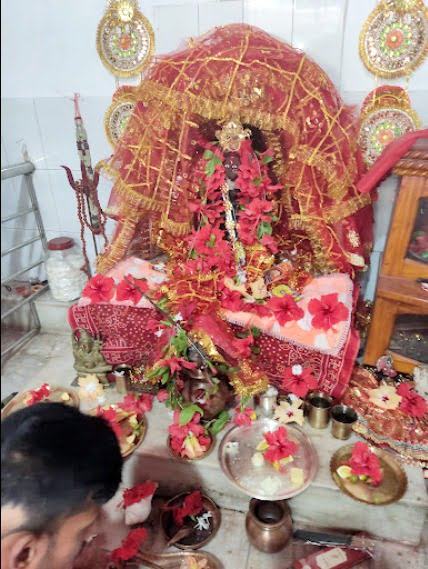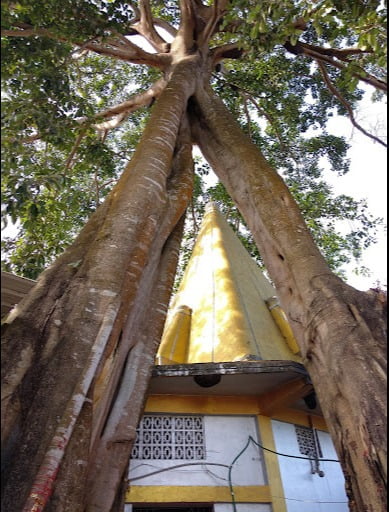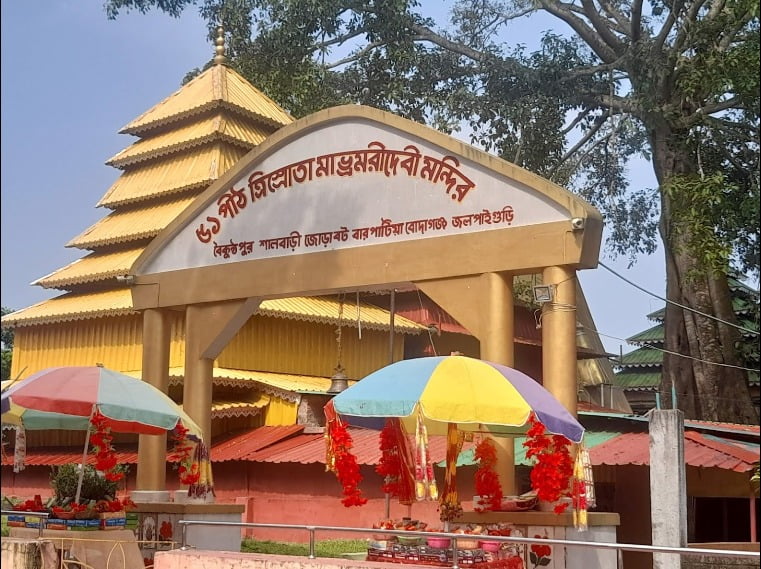Shree Trishrota Maa Bhramoree Debir Shaktipeeth Temple
Shree Trishrota Maa Bhramoree Debir Shaktipeeth Temple is a renowned Hindu temple located in the Buxa Tiger Reserve in Jalpaiguri district of West Bengal, India. It is dedicated to Goddess Bhramari, who is considered a form of Goddess Shakti. The temple holds immense religious significance and is a popular pilgrimage site for devotees.

Contents
- 1 Miracles:
- 2 Places to visit near Bhramari Devi Temple:
- 3 FAQ:
- 3.0.1 What is Shree Trishrota Maa Bhramoree Debir Shaktipeeth Temple?
- 3.0.2 What is the significance of Shree Trishrota Maa Bhramoree Debir Shaktipeeth Temple?
- 3.0.3 What are the rituals performed at Shree Trishrota Maa Bhramoree Debir Shaktipeeth Temple?
- 3.0.4 What are the benefits of visiting Shree Trishrota Maa Bhramoree Debir Shaktipeeth Temple?
- 3.0.5 What are the dos and don’ts for visiting Shree Trishrota Maa Bhramoree Debir Shaktipeeth Temple?
- 4 How to reach Bhramari Devi Temple:
- 5 Google Maps:
Here are some key features and information about the Bhramari Devi Temple:
Location: The Bhramari Devi Temple is situated within the Buxa Tiger Reserve, which is known for its rich biodiversity and natural beauty. The temple is surrounded by dense forests and offers a tranquil setting for devotees.
Mythological Significance: According to Hindu mythology, it is believed that when the body of Goddess Sati, an incarnation of Goddess Shakti, was dismembered by Lord Vishnu’s Sudarshan Chakra, the part associated with the forehead (Bhramara) fell at the present location of the temple. Thus, it is considered a Shakti Peeth, a sacred place associated with divine feminine energy.
Festival Celebrations: The temple attracts a large number of devotees, especially during the annual Bhramari Devi Mela. This festival, held in the Bengali month of Chaitra (March-April), witnesses devotees gathering to seek the blessings of Goddess Bhramari. The temple premises come alive with religious fervor, rituals, and cultural activities during this time.
Architectural Style: The Bhramari Devi Temple showcases traditional Bengali temple architecture. It has a distinct style with intricate carvings, terracotta work, and a sloping roof. The temple’s sanctum houses the idol of Goddess Bhramari, and there are other smaller shrines dedicated to various deities within the complex.
Natural Surroundings: The temple’s location within the Buxa Tiger Reserve provides visitors with an opportunity to appreciate the natural beauty of the region. The reserve is home to diverse flora and fauna, including the royal Bengal tiger, elephants, leopards, and a variety of bird species.
Visiting the Bhramari Devi Temple offers devotees and nature enthusiasts a chance to seek divine blessings, soak in the serene ambiance, and explore the surrounding wildlife and natural landscapes.
It is advisable to check the temple’s visiting hours, any specific rituals or guidelines, and the local weather conditions before planning your visit.
Read More>> Kanya Ashram Kanyakumari Temple

Miracles:
The Bhramari Devi Temple in Jalpaiguri, West Bengal, is believed to be a sacred place where devotees experience the blessings and miracles of Goddess Bhramari. While specific miracles may vary based on personal experiences and beliefs, here are some general aspects associated with the temple:
Healing Powers: Devotees believe that the Goddess Bhramari possesses healing powers and can provide relief from physical ailments and diseases. People suffering from illnesses often visit the temple to seek the goddess’s blessings for their recovery.
Fertility and Childbirth: It is believed that offering prayers to Goddess Bhramari can bless couples who are trying to conceive or seeking a healthy pregnancy and safe childbirth. Devotees pray for fertility and the well-being of their children.
Financial Stability: Many devotees seek the blessings of Goddess Bhramari for financial prosperity and stability. They believe that worshipping her can bring wealth, success, and abundance in their lives.
Protection from Evil: Devotees consider Goddess Bhramari as a protector from evil forces and negative energies. They believe that her divine presence can ward off evil influences and bring about a sense of security and peace.
Fulfillment of Desires: Devotees often visit the Bhramari Devi Temple to offer prayers and seek the fulfillment of their wishes and desires. They believe that the goddess listens to their prayers and grants their heartfelt wishes.
Spiritual Awakening: Visitors to the temple often experience a deep sense of spiritual connection and enlightenment. The serene atmosphere and the divine presence of Goddess Bhramari are believed to facilitate spiritual growth and inner transformation.
It’s important to note that miracles are subjective experiences and interpretations of individuals. The true essence of visiting the Bhramari Devi Temple lies in seeking spiritual solace, inner peace, and devotion to the goddess.
Please keep in mind that these beliefs and experiences are based on popular devotion and may vary among individuals.
Read More>> Tirumala Tirupati Venkateswara Swamy

Places to visit near Bhramari Devi Temple:
There are several places of interest near the Bhramari Devi Temple in Jalpaiguri district, West Bengal. Here are a few notable places you can consider visiting:
Gorumara National Park: Gorumara National Park is a renowned wildlife sanctuary located near the Bhramari Devi Temple. It is known for its diverse flora and fauna, including the famous Indian one-horned rhinoceros, elephants, and various species of birds. You can enjoy jeep safaris or elephant rides to explore the park’s natural beauty.
Jaldapara Wildlife Sanctuary: Located in Alipurduar district, Jaldapara Wildlife Sanctuary is another popular wildlife reserve in the region. It is home to the endangered Bengal tiger, one-horned rhinoceros, Indian elephants, and other wildlife species. Elephant safaris and jeep safaris are available for visitors to observe the wildlife up close.
Chilapata Forest: Chilapata Forest is a dense forest located near Jaldapara Wildlife Sanctuary. It offers a unique opportunity for wildlife enthusiasts and nature lovers. The forest is known for its natural beauty, diverse flora, and fauna. You can take jeep safaris or explore the forest on foot.
Buxa Tiger Reserve: Buxa Tiger Reserve is a significant wildlife sanctuary located in Alipurduar district. It is known for its rich biodiversity and stunning landscapes. The reserve is home to various wildlife species, including tigers, elephants, leopards, and many others. Trekking trails, wildlife spotting, and bird-watching are popular activities here.
Jayanti: Jayanti is a small village located near the Buxa Tiger Reserve. It is known for its scenic beauty and the Jayanti River flowing through it. The village is surrounded by hills and forests, making it a perfect spot for nature walks, bird watching, and picnics.
These are just a few examples of places you can explore near the Bhramari Devi Temple. The region is blessed with natural beauty and wildlife, providing ample opportunities for nature enthusiasts and wildlife lovers to indulge in memorable experiences.
Read More>> Dhandayuthapani Swamy Temple, Palani

FAQ:
What is Shree Trishrota Maa Bhramoree Debir Shaktipeeth Temple?
Shree Trishrota Maa Bhramoree Debir Shaktipeeth Temple is a Hindu temple located in the Buxa Tiger Reserve in Jalpaiguri district of West Bengal, India. It is dedicated to Goddess Bhramari, who is considered a form of Goddess Shakti.
What is the significance of Shree Trishrota Maa Bhramoree Debir Shaktipeeth Temple?
Shree Trishrota Maa Bhramoree Debir Shaktipeeth Temple is one of the 51 Shakti Peethas, sacred Hindu pilgrimage sites dedicated to the goddess Shakti. It is believed that the three drops of blood from the left breast of Sati, the consort of Shiva, fell here after she was beheaded by her father, Daksha Prajapati.
What are the rituals performed at Shree Trishrota Maa Bhramoree Debir Shaktipeeth Temple?
The most important ritual performed at Shree Trishrota Maa Bhramoree Debir Shaktipeeth Temple is the daily puja (worship) of the goddess. The puja is performed by the priests of the temple and involves chanting mantras and offering prayers to the goddess.
Another important ritual performed at the temple is the Bhramari Puja, which is a 10-day festival that takes place every year in July-August. During the festival, the temple is decorated with flowers and lights. Devotees from all over India come to the temple to participate in the festival.
What are the benefits of visiting Shree Trishrota Maa Bhramoree Debir Shaktipeeth Temple?
It is believed that those who visit Shree Trishrota Maa Bhramoree Debir Shaktipeeth Temple will be blessed with the following:
- Moksha: Liberation from the cycle of birth and death
- Dharma: Righteousness
- Artha: Wealth
- Kama: Pleasure
- Moksha: Liberation from the cycle of birth and death
What are the dos and don’ts for visiting Shree Trishrota Maa Bhramoree Debir Shaktipeeth Temple?
Here are some dos and don’ts for visiting Shree Trishrota Maa Bhramoree Debir Shaktipeeth Temple:
Dos:
- Dress modestly.
- Take a bath before entering the temple.
- Offer prayers to the goddess.
- Seek the blessings of the priest.
Don’ts:
- Do not speak loudly or laugh inside the temple.
- Do not eat or drink inside the temple.
- Do not touch the idols or the temple premises.
- Do not take photographs inside the temple.
How to reach Bhramari Devi Temple:
By Air:
The nearest major airport to the Bhramari Devi Temple is Bagdogra Airport, which is approximately 70 kilometers away. From the airport, you can hire a taxi or use public transportation to reach the temple. The journey from the airport to the temple takes around 2-3 hours, depending on traffic conditions.
By Train:
The closest railway station to the Bhramari Devi Temple is New Jalpaiguri Railway Station (NJP), which is well-connected to major cities in India. From New Jalpaiguri Railway Station, you can hire a taxi or take a local bus to reach the temple. The travel time from the railway station to the temple is approximately 2-3 hours.
By Road:
The Bhramari Devi Temple is located near the town of Chalsa, which is well-connected by roadways. You can reach Chalsa by bus or private car from nearby cities like Siliguri or Jalpaiguri. From Chalsa, you can hire a local taxi or take a shared jeep to reach the temple. The travel time from Chalsa to the temple is approximately 1-2 hours, depending on the road conditions.
It is advisable to check the local weather conditions, road conditions, and the temple’s visiting hours before planning your visit. Additionally, it’s recommended to dress modestly and follow any specific guidelines or rituals observed at the temple.
Please note that the above directions are general guidelines, and it’s always a good idea to check the latest transportation options, schedules, and local information before starting your journey to ensure a smooth and enjoyable visit to the Bhramari Devi Temple.
